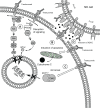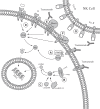Role of trastuzumab in the management of HER2-positive metastatic breast cancer
- PMID: 24367170
- PMCID: PMC3846373
- DOI: 10.2147/BCTT.S6070
Role of trastuzumab in the management of HER2-positive metastatic breast cancer
Abstract
Breast cancer is a major health issue in developed countries. Overexpression of HER2, a member of epidermal growth factor receptor family, occurs in 20%-30% of breast cancers. HER2 drives the cancer cells to develop a more aggressive phenotype, to metastasize to viscera and central nervous system, and to be less sensitive to chemotherapeutic agents. Trastuzumab (Herceptin®) is a monoclonal antibody directed against the extracellular domain of HER2. As single agent or with chemotherapy, trastuzumab improves survival of HER2-positive breast cancers. In the past years, trastuzumab has completely revolutionized the scenario of the treatment of HER2-positive breast cancer, representing one of the most remarkable examples of targeted therapy in oncology. However, issues such as the best chemotherapeutic companion to associate with trastuzumab, cardiac toxicities, and clinical resistance still require tremendous efforts by researchers. Here, we review pharmacology, efficacy studies, and toxicities of trastuzumab in metastatic breast cancer. Moreover, we provide some insights on resistance to therapy. Finally, we briefly discuss trastuzumab's place in the clinical setting.
Keywords: HER2; breast cancer; cardiotoxicity; resistance; trastuzumab.
Figures


Similar articles
-
Mechanisms of resistance to anti-human epidermal growth factor receptor 2 agents in breast cancer.Cancer Sci. 2011 Jan;102(1):1-8. doi: 10.1111/j.1349-7006.2010.01711.x. Epub 2010 Sep 6. Cancer Sci. 2011. PMID: 20825420 Review.
-
Trastuzumab and breast cancer: developments and current status.Int J Clin Oncol. 2006 Jun;11(3):199-208. doi: 10.1007/s10147-006-0575-4. Int J Clin Oncol. 2006. PMID: 16850126 Review.
-
Phase II trial of trastuzumab in combination with cytotoxic chemotherapy for treatment of metastatic osteosarcoma with human epidermal growth factor receptor 2 overexpression: a report from the children's oncology group.J Clin Oncol. 2012 Jul 10;30(20):2545-51. doi: 10.1200/JCO.2011.37.4546. Epub 2012 Jun 4. J Clin Oncol. 2012. PMID: 22665540 Free PMC article. Clinical Trial.
-
Trastuzumab: a review of its use in the treatment of metastatic breast cancer overexpressing HER2.Drugs. 2002;62(1):209-43. doi: 10.2165/00003495-200262010-00008. Drugs. 2002. PMID: 11790161 Review.
-
New developments in the treatment of HER2-positive breast cancer.Breast Cancer (Dove Med Press). 2012 May 1;4:53-64. doi: 10.2147/BCTT.S24976. Breast Cancer (Dove Med Press). 2012. PMID: 23869176 Free PMC article.
Cited by
-
HER2 copy number determination in breast cancer using the highly sensitive droplet digital PCR method.Virchows Arch. 2024 Jul;485(1):53-62. doi: 10.1007/s00428-023-03706-3. Epub 2023 Nov 23. Virchows Arch. 2024. PMID: 37996704 Free PMC article.
-
B-Cell-Based Immunotherapy: A Promising New Alternative.Vaccines (Basel). 2022 May 31;10(6):879. doi: 10.3390/vaccines10060879. Vaccines (Basel). 2022. PMID: 35746487 Free PMC article. Review.
-
Epigenetics in breast and prostate cancer.Methods Mol Biol. 2015;1238:425-66. doi: 10.1007/978-1-4939-1804-1_23. Methods Mol Biol. 2015. PMID: 25421674 Free PMC article. Review.
-
Dual targeting of HER2-positive breast cancer with trastuzumab emtansine and pertuzumab: understanding clinical trial results.Oncotarget. 2018 Aug 7;9(61):31915-31919. doi: 10.18632/oncotarget.25739. eCollection 2018 Aug 7. Oncotarget. 2018. PMID: 30159132 Free PMC article. Review.
-
Actein Inhibits Tumor Growth and Metastasis in HER2-Positive Breast Tumor Bearing Mice via Suppressing AKT/mTOR and Ras/Raf/MAPK Signaling Pathways.Front Oncol. 2020 May 27;10:854. doi: 10.3389/fonc.2020.00854. eCollection 2020. Front Oncol. 2020. PMID: 32547952 Free PMC article.
References
-
- Broekx S, Hond ED, Torfs R, et al. The costs of breast cancer prior to and following diagnosis. Eur J Health Econ. 2010 Mar 20; Epub. - PubMed
-
- Katanoda K, Yako-Suketomo H. Comparison of time trends in breast cancer mortality (1990–2006) in the world, from the WHO mortality database [abstract] Jpn J Clin Oncol. 2010;40:182. - PubMed
-
- Slamon DJ, Clark GM, Wong SG, Levin WJ, Ullrich A, McGuire WL. Human breast cancer: correlation of relapse and survival with amplification of the HER-2/neu oncogene. Science. 1987;235:177–182. - PubMed
-
- Slamon DJ, Godolphin W, Jones LA, et al. Studies of the HER-2/neu proto-oncogene in human breast and ovarian cancer. Science. 1989;244:707–712. - PubMed
-
- Harari D, Yarden Y. Molecular mechanisms underlying ErbB2/HER2 action in breast cancer. Oncogene. 2000;19:6102–6114. - PubMed
Publication types
LinkOut - more resources
Full Text Sources
Other Literature Sources
Research Materials
Miscellaneous

